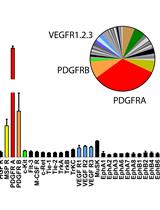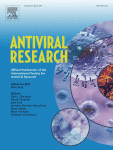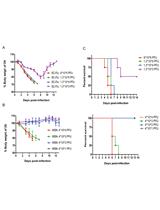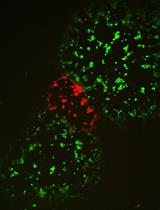- EN - English
- CN - 中文
Mouse Model of Dengue Virus Infection with Serotypes 1 and 2 Clinical Isolates
感染血清1型和2型登革热病毒临床分离株的小鼠模型
发布: 2016年12月05日第6卷第23期 DOI: 10.21769/BioProtoc.2040 浏览次数: 10570
评审: Yannick DebingLongping Victor TseAnonymous reviewer(s)

相关实验方案

利用小鼠Phospho-RTK Array试剂盒无偏筛选肿瘤提取物中激活受体酪氨酸激酶
Julian Naipauer [...] Enrique A. Mesri
2019年04月20日 5547 阅读
Abstract
Dengue is a global public health threat caused by infection with any of the 4 related dengue virus serotypes (DENV1-4). Clinical manifestations range from self-limiting febrile illness, known as dengue fever (DF), to life-threatening severe diseases, such as dengue hemorrhagic fever (DHF) or dengue shock syndrome (DSS). Most cases of DHF/DSS are associated with secondary heterotypic infections through a phenomenon that is described as antibody-dependent enhancement of infection (ADE). There are an estimated 400 million human infections and several hundred thousand cases of severe dengue occurring yearly. At present, however, there are no approved antiviral drugs against DENV infection. The lack of a suitable animal model has hampered the evaluation of novel antiviral candidates for DENV infection. Since DENV poorly establishes infection in immunocompetent mice, AG129 mice (lacking type I and II IFN [interferon] receptors) and mouse-adapted DENV2 strains have been applied to dengue animal models that enable to reproduce several of the major pathologies of human infection. Recently, we developed new mouse models with clinical isolates DENV1 and DENV2 that would be useful for drug testing and dengue pathogenesis studies (Watanabe et al., 2016). Here we describe the details to establish dengue mouse models of clinical isolates; from in vitro preparation of the materials to in vivo virus infection. Of note, since infectivity of DENV in mice differs among virus strains, not all clinical isolates can induce severe dengue.
Keywords: Dengue virus (登革热病毒)Background
To overcome the drawback that DENV does not replicate well in rodent cells, many efforts have been made over the years to develop small animal models that mimic human dengue infection. The inbred mouse model system allows experimental variability to be minimized, and genetically engineered mouse models enable to reproduce some aspects of dengue clinical symptoms in the animals. A past study showed that AG129 mice (lacking type I and II IFN receptors) infected with a DENV2 clinical isolate succumbed to infection with signs of paralysis, a condition of central nervous system involvement that is rare in human cases (Shresta et al., 2004). Alternatively, mouse-adapted DENV2 strains that can induce human DHF/DSS-like diseases in AG129 mice were generated and have been used for dengue research (Shresta et al., 2006; Zellweger et al., 2010). Although the use of the mouse-adapted strains is valuable for some aspects of DENV pathogenesis studies and potential therapeutic drug testing, one considerable limitation is the variable pathogenesis depending on the serotype/genotype, and adaptation of virus in mouse might alter tissue tropism. Recently, we developed new mouse models of clinical isolates DENV1 and DENV2; the mice succumbed to infection with signs of severe dengue symptoms (Watanabe et al., 2016). Non-lethal infection with clinical isolates becomes lethal accompanied with high levels of viremia and cytokine production in the presence of DENV antibodies (Abs) (ADE condition) in AG129 mice, suggesting that this system enables to extend the use of clinical DENV isolates for the study of Ab-mediated DENV pathogenesis and the evaluation of anti-dengue candidates.
Materials and Reagents
- 50 ml centrifuge tubes (Corning, Falcon®, catalog number: 357550 )
- 0.45 μm membrane filter (Sartorius, Minisart®, catalog number: 16537 )
- 0.2 μm membrane filter unit for bulk culture (Thermo Fisher Scientific, Thermo ScientificTM, catalog number: 567-0020 )
- HiTrap Protein G HP-5 ml (GE Healthcare, catalog number: 170-0405-01 )
- 96-well PCR plate (Bio-Rad Laboratories, catalog number: HSP9601 )
- SnakeskinTM dialysis tubing 10 kDa (Thermo Fisher Scientific, Thermo ScientificTM, catalog number: 68100 )
- 30 G insulin syringe (BD, catalog number: 328818 )
- 27 G needle (BD, catalog number: 305109 )
- 1.5 ml Eppendorf tubes (Corning, Axygen, catalog number: MCT-150-c )
- Plate cover seal (Bio-Rad Laboratories, catalog number: MSB1001 )
- CryoTubes vials for freezing viruses (Thermo Fisher Scientific, Thermo ScientificTM, catalog number: 368632 )
- Dengue virus: DENV-2 mouse-adapted S221 strain (Zellweger et al., 2010), DENV-1 clinical isolate (EDEN1: GenBank accession
EU081230.1) (Low et al., 2006), DENV2 clinical isolate (EDEN2: GenBank accession EU081177.1) (Low et al., 2006) - Cells of the Aedes albopictus C6/36 line (clone C6/36) (ATCC, catalog number: CRL-1660TM )
- Cells of the baby hamster kidney cell line (BHK-21 [C-13]) (ATCC, catalog number: CCL-10TM )
- Hybridoma cells (D1-4G2-15) (ATCC, catalog number: HB-112TM )
- Sv/129 mice deficient in type I and II IFN receptors (AG129 mice) (B&K Universal)
- RPMI1640 medium (Thermo Fisher Scientific, GibcoTM, catalog number: 11875093 )
- Heat-inactivated fetal bovine serum (FBS) (Thermo Fisher Scientific, GibcoTM, catalog number: 10082147 )
- Liquid nitrogen
- 3.7% formaldehyde (Sigma-Aldrich, catalog number: F1635 )
- Crystal violet (Sigma-Aldrich, catalog number: C3886 )
Note: This product has been discontinued. - Protein-Free hybridoma medium (PFHM-II medium) (Thermo Fisher Scientific, GibcoTM, catalog number: 12040077 )
- 1x PBS (Lonza, catalog number: 17-516Q )
- Glycine (Sigma-Aldrich, catalog number: G7126 )
- 0.25% trypsin-EDTA (Thermo Fisher Scientific, GibcoTM, catalog number: 25200056 )
- Ethylenediaminetetraacetic acid (EDTA) (EMD Millipore, catalog number: 819040 )
- QIAamp Viral RNA Mini Kit (Qiagen, catalog number: 52906 )
- qScript One-Step qRT-PCR Kit (Quantabio, catalog number: 95057 )
- Methyl-cellulose powder (EMD Millipore, catalog number: 17851 )
- L-glutamine (Thermo Fisher Scientific, GibcoTM, catalog number: 25030081 )
- Penicillin and streptomycin (PenStrep) (Thermo Fisher Scientific, GibcoTM, catalog number: 15140122 )
- 7.5% sodium bicarbonate solution (Thermo Fisher Scientific, GibcoTM, catalog number: 25080094 )
- 1 M HEPES (Thermo Fisher Scientific, GibcoTM, catalog number: 15630080 )
- Ethanol (EtOH) (EMD Millipore, catalog number: 1009832511 )
- RPMI 1640 powder (Thermo Fisher Scientific, GibcoTM, catalog number: 31800022 )
- 1 N HCl (Sigma-Aldrich, catalog number: 258148 )
- Tris (First BASE Laboratories Sdn Bhd, catalog number: BIO-1400 )
- Primers and probes
DENV1 forward primer: 5’-ACACCAGGGGCTGTACCTTGG-3’
DENV1 reverse primer: 5’-CATTCCATTTTCTGGCGTTCT-3’
DENV1 taqman probe: FAM-5’-CTGTCTCTACAGCATCATTCCAGGCA-3’-TAMRA
DENV2 forward primer: 5’-CATATTGACGCTGGGAAAGA-3’
DENV2 reverse primer: 5’-AGAACCTGTTGATTCAAC-3’
DENV2 taqman probe: FAM-5’-CTGTCTCCTCAGCATCATTCCAGGCA-3’-TAMRA - Standard for realtime RT-PCR: plasmids containing whole genome sequences of DENV-1 (EDEN1: EU081230.1) or DENV-2 (EDEN2: EU081177.1)
- 0.8% methyl-cellulose medium (see Recipes)
- 1% Crystal violet (see Recipes)
- 0.1 M glycine (pH 2.7) (see Recipes)
- 1 M Tris- HCl (pH 9.0) (see Recipes)
Equipment
- NuncTM 175 cm2 angled-neck easy flasks (Thermo Fisher Scientific, Thermo ScientificTM, catalog number: 159920 )
- Cell scraper (Corning, catalog number: 3010 )
- Incubator (SANYO, model: MIR-262 ) without CO2 atmosphere at 28 °C
- Humidified incubator (NuAire, model: NU5500 ) with 5% CO2 atmosphere at 37 °C
- Swinging rotor centrifuge (for cells) (Thermo Fisher Scientific, model: Heraeus Multifuge 3S-R )
- Benchtop fixed-angle rotor centrifuge (for serum) (Eppendorf, model: 5424 )
- -80 °C freezer (Thermo Fisher Scientific, Thermo ScientificTM, model: Forma 900 Series )
- Autoclave (TOMY DIGITAL BIOLOGY, model: SX-700 )
- AKTApurifierTM UPC 10 (GE Healthcare, catalog number: 28406268 )
- pH meter (Sartorius, model: pH Basic Series )
- NanoDrop 2000 spectrophotometer (Thermo Fisher Scientific, Thermo ScientificTM, catalog number: ND-2000 )
- Real-time thermal cycler (Bio-Rad Laboratories, model: CFX96 )
- Mouse restrainer (Plas-labs, catalog number: 551-BSRR )
- Olympus inverted fluorescence microscope (Olympus, model: IX71 )
Software
- GraphPad Prism software
Procedure
文章信息
版权信息
© 2016 The Authors; exclusive licensee Bio-protocol LLC.
如何引用
Watanabe, S., Chan, K. W. K. and Vasudevan, S. G. (2016). Mouse Model of Dengue Virus Infection with Serotypes 1 and 2 Clinical Isolates. Bio-protocol 6(23): e2040. DOI: 10.21769/BioProtoc.2040.
分类
微生物学 > 体内实验模型 > 病毒
细胞生物学 > 组织分析 > 组织分离
您对这篇实验方法有问题吗?
在此处发布您的问题,我们将邀请本文作者来回答。同时,我们会将您的问题发布到Bio-protocol Exchange,以便寻求社区成员的帮助。
提问指南
+ 问题描述
写下详细的问题描述,包括所有有助于他人回答您问题的信息(例如实验过程、条件和相关图像等)。
Share
Bluesky
X
Copy link












